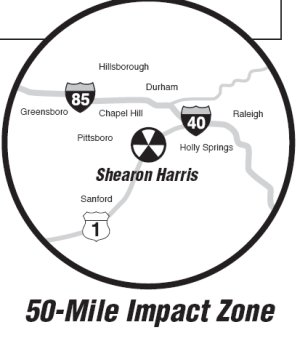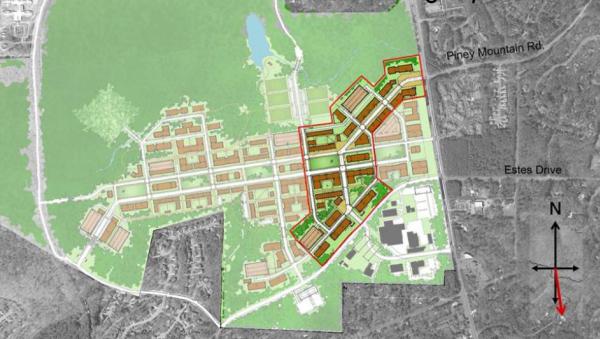The Chapel Hill News’ ‘blog OrangeChat first alerted me to the Town’s completion of the Lot #5 negotiations with RAM Development (more to come in the N&O).
The Town’s April 3rd news release celebrates what I believe will eventually be seen to be a rushed decision foisting a counter-productive, fiscally irresponsible obligation to construct expensive rental properties for out-of-town landlords on our citizen’s dime:
04/03/07 — The $75 million residential and retail complex to be constructed on Town-owned Parking Lot 5 in downtown Chapel Hill moves a step closer to reality. Town Manager Roger L. Stancil today concluded final negotiations and executed the development agreement with Ram Development Co.
April 3rd, 2007, a regrettable day in our Town’s history.
Why? According to our Town’s legal counsel, the only way now to back out of this troubled deal is to default. Default means difficult to defend lawsuits against our Town. Default means probable expensive judgments against our community. Default, after today, puts all our residents firmly on the hook for millions of dollars of expenditures.
The Council last month authorized the Manager to finalize negotiations and execute the agreement. The project will now follow the Town’s normal regulatory process for a Special Use Permit, including review by the Town’s advisory boards and commissions and a public hearing before the Council.
While they did authorize the Town Manager to proceed with negotiations, the Council also directed Roger Stancil to achieve certain goals – like a firm commitment to improve energy efficiency as per ASHRAE 90.1 20% efficiency standards and an increase on-site affordable housing parking.
Without the final modified agreement (not available this evening), it is not clear our Town Manager achieved these goals. Further, for the partial success reported – 5 additional on-site parking – the trade-offs required by RAM to get those spaces remains unknown.
Final negotiations centered on energy efficiency construction. Recognizing the importance of reducing the energy demand of buildings and dependence on energy from fossil fuels, the Council directed that the agreement require the design and construction of the project to meet a minimum 20 percent improvement in energy efficiency (as measured against standards established by the American Society of Heating, Refrigerating and Air-Conditioning Engineers – ASHRAE).
Again, the language of the announcement leaves it somewhat unclear, at least to me, if the commitment to the ASHRAE 90.1 %20 energy efficiency standard is measurably firm.
[
UPDATE] From
today’s N&O
As part of the final contract, Ram agreed to achieve an energy efficiency level 20 percent better than standards established by the American Society of Heating, Refrigerating and Air-Conditioning Engineers.
It appears the LEEDs trade-off discussed here was the key to ASHRAE acceptance. Of course, without the final contract before us it’s difficult to ascertain how compliance with ASHRAE or LEEDs will be measured.
The project will incorporate sustainable, “green†features that will result in at least 26 points under Leadership in Environment and Energy Design (LEED) standards, the equivalent minimum number of points for basic certification under the LEED system. The Council has established a Town-wide goal to reduce carbon dioxide emissions by 60 percent by 2050 through the Carbon Reduction Program.
Councilmember Sally Greene suggested trading the potentially expensive formal LEEDs review for simple compliance with the LEEDs basic certification goals. Councilmember Jim Ward countered that RAM Development’s assertion of compliance was insufficient – that the review process was a necessary element to achieving those goals. I lean more towards Sally on this with the proviso that a specific, standards-based methodology for measuring compliance outside of the LEEDs process be agreed upon prior to a final commitment (would’ve been nice to also pursue some of the AIA’s 2030 sustainability goals). Again, sans the modified agreement, it’s unclear whether any process for measuring LEEDs compliance is in place.
To the Town’s credit, the environmental reports I asked for in my Mar. 27 petition were provided as part of the announcement.
The completed environmental assessment report will be on the Town’s website. The assessment detected no underground gasoline tanks, only limited sections of petroleum-impacted soil that will require remediation.
Timed too late for our talented citizens with expertise in geology and environmental remediation to influence Stancil’s decision, this coincident release demonstrates, once again, the ascendancy of clever political gamesmanship over good public policy.
This bit of Town PR vastly downplays the caveats and disclaimers the authors used:
The report’s findings are based on conditions that existed on the dates of ECS’s site visits and should not be relied upon to precisely represent conditions at any other time. ECS did not assess areas other than those discussed in the report.
The conclusions included in this report are based on: ECS’s observation of existing site conditions; our interpretation of site history and site usage information; and the results of a limited program of subsurface assessment, sample screening, and chemical testing. The concentration of contaminants ECS measured may not be representative of conditions between locations sampled. Be aware that conditions may change at any sampled or unsampled location as a function of time in response to natural conditions, chemical reactions, and/or other events.
Conclusions about site conditions under no circumstances comprise a warranty that conditions in all areas within the site and beneath structures are of the same quality as those sampled. Recognize, too, that contamination might exist in forms not indicated by the assessment ECS conducted.
April 2nd’s letter from ECS Carolinas, LLP concerning the “Phase II ESA and Limited Soil Delineation Report”, p. 2
Based on approximate measurements of the property boundary and sample locations, ECS estimates that approximately 8,600 cubic yards (~13,000 tons assuming 1.5 tons per cubic yard) of petroleum-impacted soil may be present at the site. This is a preliminary estimate only; the actual quantity of potentially impacted soils may vary based on conditions observed during soil excavation. [CW: EMPHASIS by ECS]
April 2nd’s letter from ECS Carolinas, LLP concerning the “Phase II ESA and Limited Soil Delineation Report”, p. 6
The concerns of the report’s authors are clear. What is left unsupported is the Town’s cost estimate.
The estimated cost of the clean-up will be $232,000. The Town will assume the costs for remediation, and the developer will fund the excavation.
So, RAM Development will pick up the tab for excavating 13,000 tons/8600 cubic yards of hazardous material and the Town will pay, I assume, to haul it safely off-site and dispose of it in an acceptable manner. Given the author’s caveats and the lack of discussion of hazardous material intrusions into the underlying bedrock, I’d like to see the analysis behind the $232,000 cost estimate.
Is it as solid as RAM Development’s Spring 2006 claim of a total $500,000 in public outlays? I hope not since a 15-fold increase in the environmental costs, similar to the 10 month increase from $500,000 to $7,425,000 for those 161 buried parking spaces, would be in the neighborhood of $3.5 million!
One notable improvement in our Town’s communications is a savvy ability to propagandize, making a gold-filled silk purse out of the hazardous waste sows ear by now trumpeting development on “brownfields”.
“Developing a project in downtown reflects Chapel Hill’s commitment to build on brownfields rather than greenfields in order to preserve our environment,†said Manager Roger L. Stancil. “Brownfields are properties where redevelopment or reuse can be complicated by the presence or potential presence of pollutants or contaminants from past use. Developing on greenfields is to build on undeveloped properties on the urban fringe, often farmland. Chapel Hill intends to keep the greenfields green.â€
A month ago we weren’t supposed to worry about hazardous waste on Lot #5. Today it’s an asset.
There’s a lot of fertile “brown” in the “fields” lay bare by this announcement. Once again, the liabilities are down-played, the potential fiscal “surprises” ignored, the value of the project over-stated while the obligations continue to be heaped upon our citizens.
April 3rd, 2007, a regrettable day in Chapel Hill’s history.













